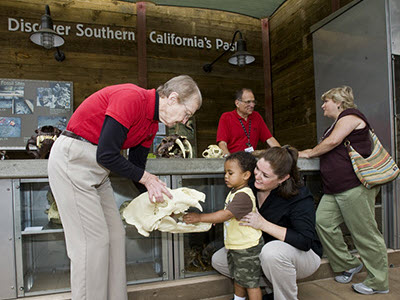 |
Budgeting: Operating Budgets |
1.00 |
An operating budget is a projection of the entire income statement of a company, or department. Operating budgets manage the operations of a company or department. They include the expenses associated with manufacturing, selling, and distributing products. Operating budgets also help to administer the daily functioning of the company. They project the expenses a company will incur in its manufacturing facilities, as well as the revenue that it will generate. |
 |
Managerial Leadership: Leading with a Vision (Instructor Guide) |
1.50 |
An organization does not generate itself—it is founded by one or more people who take the initiative to put an idea into action. Leadership is the cement that unites members of an organization to achieve a common end.
Leadership helps members of an organization understand the organization’s purpose, and makes sure they do not lose sight of the organization’s vision. If an organization functions ineffectively, leadership helps members cope with the changes needed to improve the organization, enabling fulfillment of the vision or goals.
Leadership also helps members of an organization work to their full potential. If a team has the ability and resources to complete a task, leadership can provide the motivation and inspiration the team needs to complete the task.
In this course you will learn to: Identify a leader, define the vision of an organization and write a vision statement, and relate goals to the vision statement.
This Instructor's Edition of this course includes notes and suggestions to assist you in presenting the material, whether in an in-person classroom setting or as an instructor-led online or distance-learning course. It also provides you with the answers to questions found in mid-lesson activities, as well as in the quiz that concludes the course. |
 |
Managerial Leadership: Leading with a Vision |
1.50 |
An organization does not generate itself—it is founded by one or more people who take the initiative to put an idea into action. Leadership is the cement that unites members of an organization to achieve a common end.
Leadership helps members of an organization understand the organization’s purpose, and makes sure they do not lose sight of the organization’s vision. If an organization functions ineffectively, leadership helps members cope with the changes needed to improve the organization, enabling fulfillment of the vision or goals.
Leadership also helps members of an organization work to their full potential. If a team has the ability and resources to complete a task, leadership can provide the motivation and inspiration the team needs to complete the task.
In this course you will learn to: Identify a leader, define the vision of an organization and write a vision statement, and relate goals to the vision statement. |
 |
Advanced Interpersonal Communication: Organizational Culture (Instructor Guide) |
1.34 |
An organizational culture is the personality of an organization. This personality is both determined and accepted by the organization’s members. For example, an organization might have a culture that is youthful, energetic, and fast-paced. In this type of culture, decisions are made quickly, and employees are empowered to take action in a wide variety of situations. Another organization might be more straight-laced and policy-oriented. This organization would be much more formal and serious in the way it does business. It is important to recognize and understand the culture of an organization, so that you can determine your fit with the organization.
In this course you will learn: to determine the nature of an organization’s culture, to use the cultural network to your advantage, and identify the characteristics of the roles exhibited in the network, to identify the elements of physical culture that affect interpersonal communication, and to identify the ways in which managers can build a positive culture.
This Instructor's Edition of this course includes notes and suggestions to assist you in presenting the material, whether in an in-person classroom setting or as an instructor-led online or distance-learning course. It also provides you with the answers to questions found in mid-lesson activities, as well as in the quiz that concludes the course. |
 |
Advanced Interpersonal Communication: Organizational Culture |
1.34 |
An organizational culture is the personality of an organization. This personality is both determined and accepted by the organization’s members. For example, an organization might have a culture that is youthful, energetic, and fast-paced. In this type of culture, decisions are made quickly, and employees are empowered to take action in a wide variety of situations. Another organization might be more straight-laced and policy-oriented. This organization would be much more formal and serious in the way it does business. It is important to recognize and understand the culture of an organization, so that you can determine your fit with the organization.
In this course you will learn: to determine the nature of an organization’s culture, to use the cultural network to your advantage, and identify the characteristics of the roles exhibited in the network, to identify the elements of physical culture that affect interpersonal communication, and to identify the ways in which managers can build a positive culture. |
 |
Managerial Leadership: Making Vision a Reality |
1.00 |
An organization’s vision must be communicated in a manner that inspires people to participate in fulfilling it. Before members of an organization work to their full potential, they must first understand what it is they are working for—to make the organization’s vision a reality.
It is through communication that a leader gains support for the organization’s vision. People will not commit to something blindly, nor should they be expected to commit without information. Therefore, when, how, and to whom an organization’s vision is communicated is of great importance to the successful fulfillment of the vision.
Your organization’s vision must be communicated to the people who’ll have a hand in fulfilling it, as well as to the people who’ll be affected by it, such as clients or investors. Your organization’s vision should also be communicated to potential employees, or other people in the community who come into contact with your organization.
In this course you will learn to: communicate the vision, gain support for the vision, and empower employees, and implement the organization’s vision. |
 |
Managerial Leadership: Making Vision a Reality (Instructor Guide) |
1.00 |
An organization’s vision must be communicated in a manner that inspires people to participate in fulfilling it. Before members of an organization work to their full potential, they must first understand what it is they are working for—to make the organization’s vision a reality.
It is through communication that a leader gains support for the organization’s vision. People will not commit to something blindly, nor should they be expected to commit without information. Therefore, when, how, and to whom an organization’s vision is communicated is of great importance to the successful fulfillment of the vision.
Your organization’s vision must be communicated to the people who’ll have a hand in fulfilling it, as well as to the people who’ll be affected by it, such as clients or investors. Your organization’s vision should also be communicated to potential employees, or other people in the community who come into contact with your organization.
In this course you will learn to: communicate the vision, gain support for the vision, and empower employees, and implement the organization’s vision.
This Instructor's Edition of this course includes notes and suggestions to assist you in presenting the material, whether in an in-person classroom setting or as an instructor-led online or distance-learning course. It also provides you with the answers to questions found in mid-lesson activities, as well as in the quiz that concludes the course. |
 |
San Diego Zoo - Interpretation Basics: Module 1 |
2.50 |
An understanding of interpretation techniques is increasingly important for professionals and volunteers in zoos, aquariums, museums, and a variety of other tourism and hospitality organizations. This course will introduce the basics of interpretation, including the origins of interpretation, Tilden’s Six Principles of Interpretation, connecting tangibles with intangibles, and understanding visitors’ needs and motivations. |
 |
Grow and Thrive while Becoming Greener |
1.00 |
Andrew Fischer, Retail General Manager of the world renowned Monterey Bay Aquarium and Green Team Chairman for Service Systems Associates (SSA) will be presenting information about his company’s successful eco-efforts and how your organization can also grow and thrive while becoming greener. He will also review some of the challenges and opportunities that his company has dealt with over the years – and the many success stories his team has been inspired to pursue. Topics in this course will include:
- Partnering with your client or vendor to build a green team
- Learning green practices from others
- Establishing eco-friendly standards
- Communicating with your green team and locations
- Project programs – examples of successes and challenges
- Green financial vision
Andrew, as a representative of Service Systems Associates can provide additional information and resources for you to build a greener and healthier business |
 |
Anger Management |
1.00 |
Anger is a set of physical responses, emotions, and behaviors triggered by a perceived threat or frustration. Anger can be harmful or helpful, depending on how you cope with your anger and the anger of others. This course will explore how to understand your anger better and manage your anger responses. You'll also examine the causes of anger and ways to use it constructively. |











